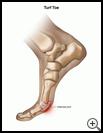
Turf Toe
________________________________________________________________________
KEY POINTS
- Turf toe is a sprain at the joint where your big toe attaches to the rest of your foot.
- You may need to change or stop doing the activities that cause pain until your toe has healed.
- Treatment may include taping your big toe to provide support and limit movement, wearing orthotics, or medicine.
________________________________________________________________________
What is turf toe?
Turf toe is a sprain at the joint where your big toe attaches to the rest of your foot. A sprain is an injury to a ligament, which is a strong band of tissue that connects one bone to another.
What is the cause?
A sprain is caused by a sudden activity that twists or tears a ligament. Turf toe can result from pushing off on one foot and using the big toe too hard when you run or jump. Jamming your toe into a hard surface, such as artificial turf, can also cause turf toe.
What are the symptoms?
Symptoms may include:
- Pain and swelling where your big toe attaches to your foot
- Trouble bending and straightening your toe
How is it diagnosed?
Your healthcare provider will ask about your symptoms and your medical history and examine you. Tests may include:
- X-rays
- Blood tests to check for other problems, such as gout, which is a type of arthritis
How is it treated?
You may need to change or stop doing the activities that cause pain until your toe has healed. Your provider may show you how to tape your big toe to provide support and limit movement.
Your provider may give you a shot of a steroid medicine into the toe joint.
How can I take care of myself?
Follow the full course of treatment prescribed by your healthcare provider. In addition:
- Wear shoes that fit well.
- Take an anti-inflammatory medicine, such as ibuprofen, as directed by your provider. Nonsteroidal anti-inflammatory medicines (NSAIDs) may cause stomach bleeding and other problems. These risks increase with age. Read the label and take as directed. Unless recommended by your healthcare provider, do not take for more than 10 days.
- Keep your foot up on a pillow when you sit or lie down.
- Put an ice pack, gel pack, or package of frozen vegetables wrapped in a cloth on the area every 3 to 4 hours for up to 20 minutes at a time.
- Your healthcare provider may recommend shoe inserts, called orthotics. You can buy orthotics at a shoe store or they can be custom-made.
Ask your provider:
- How long it will take to recover
- If there are activities you should avoid and when you can return to your normal activities
- How to take care of yourself at home
- What symptoms or problems you should watch for and what to do if you have them
Make sure you know when you should come back for a checkup. Keep all appointments for provider visits or tests.

